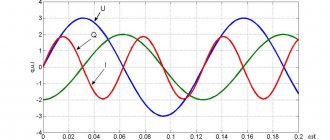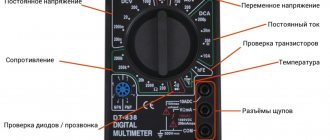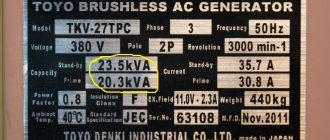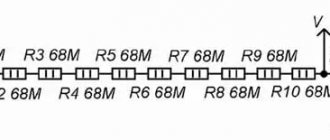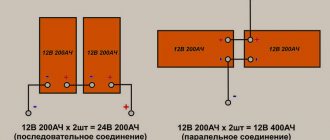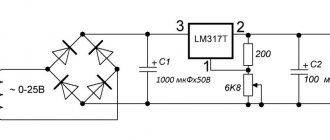When studying Ohm's law at school, students are often faced with the following questions: what is the name of the unit of voltage or how is electrical voltage measured? This article will help you understand this topic and you will be able to find out the answer to this question.
Volt is a unit of measurement of electrical potential, potential difference, electrical voltage and electromotive force.
The unit of voltage measurement is volts, in Russia it is designated by the letter V, the international designation is V.
The volt is a unit of measurement of electrical voltage, named after the famous Italian physicist Alessandro Volta, to whom we should be grateful for the invention in 1799 of the world's first chemical current source, i.e. the first electric battery ("Volta Column"), the results of the experiment were published only in 1800.
In 1861, the unit of measurement volts was adopted by the Electrical Standards Committee established by William Thomson.
The volt received its international recognition as a unit of measurement of voltage in 1960, when the volt was approved by the decision of the XI General Conference on Weights and Measures as a derived unit of the International System of Units.
1 V=1 J/1 C (1 Volt is equal to the electrical voltage at the section of the circuit where, when a charge equal to 1 coulomb (C) flows, work equal to 1 J is performed)
In the Russian Federation, basic SI units, derived SI units and individual non-systemic units of quantities are allowed for use.
In particular, GOST 8.417-2002 is in force, which establishes the units of physical units used in our country, their name, designation and definition; this state standard also specifies the unit of measurement of voltage - volts.
General information
When climbing a mountain, we do work against the force of gravity
Since we live in the era of electricity, many of us are familiar with the concept of electrical voltage from childhood:
After all, sometimes, while exploring the surrounding reality, we received a considerable shock from him by secretly sticking a couple of fingers into the power socket of electrical devices, secretly from our parents.
Since you are reading this article, nothing particularly terrible has happened to you - it is difficult to live in the era of electricity and not become briefly acquainted with it. With the concept of electric potential,
the situation is somewhat more complicated.
Being a mathematical abstraction, the electric potential is best described by analogy by the action of gravity - the mathematical formulas are absolutely similar, except that negative gravitational charges do not exist, since mass is always positive and at the same time electric charges can be both positive and negative; Electric charges can both attract and repel. As a result of the action of gravitational forces, bodies can only attract, but cannot repel. If we could deal with negative mass, we would master antigravity.
But you just have to push off...
The concept of electric potential plays an important role in describing phenomena related to electricity. Briefly, the concept of electric potential describes the interaction of charges of different or identical signs or groups of such charges.
From the school physics course and from everyday experience, we know that when climbing a mountain, we overcome the force of gravity of the Earth and, thereby, do work against the forces of attraction acting in the potential gravitational field. Since we have some mass, the Earth tries to reduce our potential - to pull us down, which we gladly allow it, rapidly skiing and snowboarding. Similarly, an electric potential field tries to bring like charges closer together and repel like charges.
It follows from this that every electrically charged body tries to lower its potential by getting as close as possible to a powerful source of an electric field of the opposite sign, if no forces prevent this. In the case of charges of the same sign, each electrically charged body tries to lower its potential by moving as far as possible from a powerful source of electric field of the same sign, if no forces prevent this. And if they interfere, then the potential does not change - while you are standing on level ground at the top of the mountain, the force of the Earth’s gravitational attraction is compensated by the reaction of the support and nothing pulls you down, only your weight presses on your skis. But you just have to push off...
Similarly, the field created by some charge acts on any charge, creating the potential for its mechanical movement towards itself or away from itself, depending on the sign of the charge of the interacting bodies.
"Sisyphus", Titian, Prado Museum, Madrid, Spain
Electric potential
A charge introduced into an electric field has a certain amount of energy, i.e., the ability to do work. To characterize the energy stored at each point of the electric field, a special concept was introduced - electric potential. The potential of the electric field at a given point is equal to the work that the forces of this field can do when moving a unit of positive charge from this point outside the field.
Returning to the analogy with the gravitational field, we can find that the concept of electric potential is akin to the concept of the level of various points on the earth's surface. That is, as we will consider below, the work of raising a body above sea level depends on how high we raise that body, and similarly, the work of moving one charge away from another depends on how far these charges are.
Let's imagine the hero of the ancient Greek world, Sisyphus. For his sins in earthly life, the gods sentenced Sisyphus to do hard, meaningless work in the afterlife, rolling a huge stone to the top of a mountain. Obviously, to lift a stone halfway up the mountain, Sisyphus needs to spend half as much work as to lift the stone to the top. Then the stone, by the will of the gods, rolled down the mountain, doing some work. Naturally, a stone raised to the top of a mountain of height H
(level H), when descending, will be able to do more work than a stone raised to level
H
/2. Sea level is generally considered to be the zero level, from which altitude is measured.
By analogy, the electrical potential of the earth's surface is considered zero potential, that is
ϕEarth = 0
where ϕEarth is the designation of the Earth’s electrical potential, which is a scalar quantity (ϕ is a letter of the Greek alphabet and is read as “phi”).
This quantity quantitatively characterizes the field’s ability to do work (W) to move some charge (q) from a given point in the field to another point:
ϕ = W/q
The SI unit of electrical potential is the volt (V).
Visitors to the Canadian Science and Technology Museum spin a large squirrel wheel, which spins a generator that powers a Tesla transformer (pictured right), which in turn creates a high voltage of several tens of thousands of volts, enough to puncture the air.
Ohm's law
Well, dear friends, I think we didn’t waste our time. Having become familiar with our plumbing models, a puzzle began to take shape in my head and an understanding began to form.
It will be interesting➡ Circuit breakers
Well, let's try to check it using Ohm's law.
Where:
- I - current measured in Amperes (A);
- U-voltage measured in Volts (V);
- R-resistance measured in Ohms (Ohm)
Ohm told us that electric current is directly proportional to voltage and inversely proportional to resistance.
I didn’t talk about resistance today, but I think you understand. The resistance to electric current is the material of the conductor. In our plumbing system, resistance to the flow of water is provided by rusty pipes clogged with rust and other things.
Thus, Ohm's law works in all its glory, both for the plumbing system and for the electrical one. Maybe I should go into plumbing, there are a lot of similarities.
The higher the water tank is raised, the faster the water will flow through the pipes. But if the pipes are dirty, the speed will be lower. The greater the resistance to water, the slower it will flow. If there is a blockage, then the water may rise altogether.
Well, for electricity. The magnitude of the current depends directly on the voltage (potential difference), and inversely depends on the resistance.
The higher the voltage, the greater the current, but the greater the resistance, the less the current. The voltage may be very high, but current may not flow due to an open circuit. And a break is the same as if, instead of a metal conductor, we connected a conductor made of air, and the air simply has a gigantic resistance. This is where the current stops.
Voltage
One definition of electrical voltage describes it as the difference in electrical potential, which is given by the formula:
V = ϕ1 – ϕ2
The concept of voltage was introduced by the German physicist Georg Ohm
in a paper in 1827, which proposed a hydrodynamic model of electric current to explain Ohm’s empirical law discovered by him in 1826:
Tesla Transformer at the Canadian Science and Technology Museum
V = I R,
where V is the potential difference, I is the electric current, and R is the resistance.
Another definition of electric voltage is the ratio of the work done by the field to move a charge in a conductor to the magnitude of the charge.
For this definition, the mathematical expression for voltage is described by the formula:
V=A/q
Voltage, like electrical potential, is measured in volts
(V) and its decimal multiples and submultiples - microvolts (millionths of a volt, µV), millivolts (thousandths of a volt, mV), kilovolts (thousands of volts, kV) and megavolts (millions of volts, MV).
A voltage of 1 V is considered to be the voltage of an electric field that does 1 J of work to move a charge of 1 C. The dimension of voltage in the SI system is defined as
B = kg•m²/(A•s³)
Voltage can be created by various sources: biological objects, technical devices, and even processes occurring in the atmosphere.
Shark lateral line
The elementary cell of any biological object is a cell, which from the point of view of electricity is an electrochemical generator of low voltage. Some organs of living beings, such as the heart, which is a collection of cells, produce higher voltage. It is curious that the most advanced predators of our seas and oceans - sharks of various species - have a hypersensitive voltage sensor called the lateral line organ
, and allowing them to accurately detect their prey by heartbeat. Separately, it is perhaps worth mentioning electric stingrays and eels, which in the process of evolution have developed the ability to create voltages of over 1000 V to defeat prey and repel attacks on themselves!
Although people have been generating electricity, and thereby creating a potential difference (voltage), by rubbing a piece of amber on wool since ancient times, historically the first technical voltage generator was the galvanic cell
.
It was invented by the Italian scientist and doctor Luigi Galvani
, who discovered the phenomenon of potential difference arising when different types of metal and electrolyte come into contact.
This idea was further developed by another Italian physicist Alessandro Volta
.
Volta first placed plates of zinc and copper in acid to produce a continuous electric current, creating the world's first chemical current source. By connecting several of these sources in series, he created a chemical battery, the so-called “Volta Column
,” which made it possible to generate electricity using chemical reactions.
The Voltaic Pole is a replica made by an electrician at the Alessandro Volta Museum in Como, Italy. Canadian Science and Technology Museum in Ottawa
Due to his achievements in creating reliable electrochemical voltage sources, which played a significant role in further research into electrophysical and electrochemical phenomena, the unit of measurement of electrical voltage, the Volt, was named after Volt.
Among the creators of voltage generators, it is necessary to note the Dutch physicist Van der Graaff
, who created
a high-voltage generator
, which is based on the ancient idea of separation of charges using friction - remember amber!
The fathers of modern voltage generators were two remarkable American inventors - Thomas Edison
and
Nikola Tesla
. The latter was an employee at Edison's company, but the two geniuses of electrical engineering disagreed on methods of generating electrical energy. As a result of the subsequent patent war, all of humanity won - Edison's reversible machines found their niche in the form of generators and DC motors, numbering in the billions of devices - just look under the hood of your car or just press the power window button or turn on the blender; and the methods of creating alternating voltage in the form of alternating current generators, devices for converting it in the form of voltage transformers and transmission lines over long distances and countless devices for its application rightfully belong to Tesla. Their number is in no way inferior to the number of Edison’s devices - fans, refrigerators, air conditioners and vacuum cleaners, and a host of other useful devices, the description of which is beyond the scope of this article, operate on Tesla principles.
Housed at the Canadian Science and Technology Museum in Ottawa, this motor-generator, manufactured by Westinghouse in 1904, was used as a reliable power source to generate the exciter magnetic field at a hydroelectric power station in Niagara Falls, NY. NY. The construction of the power plant was led by Nikola Tesla and George Westinghouse
Of course, scientists later created other voltage generators based on other principles, including the use of nuclear decay energy. They are designed to serve as a source of electrical energy for space envoys of humanity into deep space.
But the most powerful source of electrical voltage on Earth, not counting individual scientific installations, is still natural atmospheric processes.
Every second, over 2 thousand thunderstorms rumble on Earth, that is, tens of thousands of natural Van der Graaff generators operate simultaneously, creating voltages of hundreds of kilovolts, discharging currents of tens of kiloamperes in the form of lightning. But, surprisingly, the power of terrestrial generators cannot be compared with the power of electrical storms that occur on the Earth’s sister - Venus - not to mention huge planets like Jupiter and Saturn.
How tension occurs
Before considering units of measurement of electrical voltage, it is necessary to find out the nature of this phenomenon. The atoms of any substance contain a nucleus that carries a “plus” charge, and electrons with a “minus” one that quickly rotate around. Since the number of fast particles is identical to the number of protons in the nucleus, in the normal state the atom has no charge. But when one or more electrons are eliminated, the atom will begin to try to attract the missing ones, forming a positive field near itself. A negative field potential occurs when additional electrons appear.
It will be interesting➡ The gimlet rule
When the positive and negative potentials collide, a two-way attraction occurs between them. The more the potentials differ, the more actively the electrons contained in the negatively charged material move to a charge with the opposite sign, and the correspondingly greater the electric field voltage.
When the potentials of oppositely charged conductor elements connect, an electric current appears. This is the name given to the targeted movement of charged particles, trying to eliminate the potential difference. In order for charges to move along a conductor, the electric field performs work, characterized by voltage.
Voltage characteristics
Voltage is characterized by its magnitude and shape. Regarding its behavior over time, a distinction is made between constant voltage (not changing over time), aperiodic voltage (changing over time) and alternating voltage (changing over time according to a certain law and, as a rule, repeating itself after a certain period of time). Sometimes, to achieve certain goals, the simultaneous presence of direct and alternating voltages is required. In this case, we talk about alternating current voltage with a constant component.
This voltmeter was used to measure voltage at the beginning of the 20th century. Canadian Science and Technology Museum in Ottawa
In electrical engineering, DC generators (dynamos) are used to create a relatively stable high-power voltage; in electronics, precision DC voltage sources are used on electronic components, which are called stabilizers
.
Varieties
There are two types: constant and variable. The first is in electrostatic types of circuits and those that have direct current. Variable occurs where there is sinusoidal energy. It is important that sinusoidal energy is divided into effective, instantaneous and average rectified. The unit of measurement for electric current voltage is volt.
It is also worth noting that the amount of energy between the phases is called the linear phase, and the indicator of the ground and phase current is called the phase current. A similar rule is used in all overhead lines. On the territory of the Russian Federation, the standard household electrical network is 380 volts, and the phase network is 220 volts.
Main varieties
Constant pressure
Constant is the difference between electrical potentials, at which the same value remains the same with polarity changes over a specific period. The main advantage of constant energy is the fact that there is no reactive power. This means that all the power that is generated by the generator is consumed by the load, excluding wire losses. Flows throughout the entire conductor cross-section.
As for the disadvantages, there is the difficulty of increasing with decreasing energy, that is, at the moment of converting it due to the design of the converters and the lack of powerful semiconductor switches. In addition, it is difficult to decouple high and low energy.
Note! Constant energy is used in electronic circuits, galvanic cells, batteries, electrolysis plants, welding tools, inverter converters and many other devices.
D.C
AC voltage
An alternating current is a current that changes in magnitude and direction periodically, but at the same time maintains its direction in an electrical circuit unchanged. It is often called sinusoidal. One direction in which energy moves is called positive, and the other is called negative. Therefore, the resulting quantity is called positive and negative. This exponent is an algebraic quantity. In answer to the question of what the unit of voltage is called, it should be noted that it is a volt. Its value is determined by direction. The maximum value is amplitude. It happens:
- two-phase;
It will be interesting➡ Stray currents and ways to deal with them
Two-phase
- three-phase;
Three-phase
- multiphase.
Multiphase
It is actively used in industry, at a power station, at a transformer substation and is transmitted to every home using electrical transmission lines. Mostly three phases are used for connection. This type of electrification is common on many railways.
Note! It is worth noting that there are also some types of dual-system electric locomotives, which operate in many cases at a variable rate.
Alternating current
Voltage measurement
Voltage measurement plays an important role in fundamental physics and chemistry, applied electrical engineering and electrochemistry, electronics and medicine, and in many other branches of science and technology. It is perhaps difficult to find branches of human activity, excluding creative fields such as architecture, music or painting, where voltage measurements would not be used to control ongoing processes using various types of sensors, which are essentially converters of physical quantities into voltage. Although it is worth noting that in our time these types of human activities cannot do without electricity in general and without voltage in particular. Artists use tablets that measure the voltage of capacitive sensors when a stylus is moved over them. Composers play electronic instruments that measure the voltage on the key sensors and, depending on it, determine how hard a particular key is pressed. Architects use AutoCAD and tablets, which also measure voltage, which is converted into a numerical form and processed by a computer.
A kitchen thermometer (left) measures the temperature of meat by measuring the voltage across a resistive temperature sensor through which a small current is passed. In a multimeter (right), temperature is determined by measuring the voltage directly across the thermocouple
The measured voltage values can vary widely: from fractions of a microvolt in studies of biological processes, to hundreds of volts in household and industrial devices and appliances, and up to tens of millions of volts in ultra-powerful particle accelerators. Voltage measurement allows us to monitor the condition of individual organs of the human body by taking encephalograms
brain activity.
Electrocardiograms
and
echocardiograms
provide information about the condition of the heart muscle. Using various industrial sensors, we successfully, and most importantly, safely, control chemical production processes, which sometimes occur at extreme pressures and temperatures. And even nuclear processes at nuclear power plants can be controlled by measuring voltages. Using stress measurements, engineers monitor the condition of bridges, buildings and structures and even withstand such formidable natural forces as earthquakes.
A pulse oximeter, like a voltmeter, measures the voltage at the output of a device that amplifies the signal from a photodiode or phototransistor. However, unlike a voltmeter, here on the display we see not the voltage value in volts, but the percentage of hemoglobin saturation with oxygen (97%).
The brilliant idea of connecting different values of voltage levels with the state values of units of information gave impetus to the creation of modern digital devices and technologies. In computing, a low voltage level is interpreted as a logical zero (0), and a high voltage level is interpreted as a logical one (1).
In fact, all modern computing devices are, to one degree or another, voltage comparators (meters), converting their input states according to certain algorithms into output signals.
Among other things, accurate voltage measurements form the basis of many modern standards, the implementation of which guarantees their absolute compliance and thus safety of use.
The memory board used in personal computers contains tens of thousands of logic gates.
What is the voltage?
Voltage is directly related to current work, charge and resistance. To measure the voltage directly in an electrical circuit, you need to connect a voltmeter to it. It is connected to the circuit in parallel, unlike an ammeter, which is connected in series. The clamps of the measuring device are attached to those points between which the voltage needs to be calculated. For it to display the value correctly, you need to turn on the circuit. In the diagrams, the voltmeter is indicated by the letter V surrounded by a circle.
Image of a voltmeter and an electrical circuit
Voltage is denoted in Latin [U], and is measured in [V]. It is equal to the work that the field does when moving a unit charge. The formula for current voltage is U = A/q, where A is the work done by the current, q is the charge, and U is the voltage itself.
Note! Unlike a magnetic field, where charges are stationary, in an electric field they are in constant motion.
Electric field
Voltage measuring instruments
In the course of studying and understanding the surrounding world, methods and means of measuring voltage have evolved significantly from primitive organoleptic methods
- Russian scientist Petrov cut off part of the epithelium on the fingers to increase sensitivity to the action of electric current - to the simplest voltage indicators and modern devices of various designs based on the electrodynamic and electrical properties of various substances.
The taste of electricity. Once upon a time, a long time ago, if there was no voltmeter, we determined the voltage with our tongue!
By the way, novice radio amateurs easily distinguished a “working” 4.5 V flat battery from a “dead” one without any devices due to their complete absence, simply by licking its electrodes. The electrochemical processes that took place gave a feeling of a certain taste and a slight burning sensation. Some outstanding individuals undertook to determine the suitability of even 9 V batteries in this way, which required considerable endurance and courage!
An example of the simplest indicator - a mains voltage probe - can be an ordinary incandescent lamp with an operating voltage not lower than the mains voltage. There are simple voltage probes available on sale using neon lamps and LEDs that consume low currents. Be careful, using homemade structures can be dangerous to your life!
It should be noted that devices for measuring voltage (voltmeters) differ greatly from each other, primarily in the type of voltage being measured - these can be direct or alternating current devices. In general, in measurement practice, the behavior of the measured voltage is important - it can be a function of time and have a different form - be constant, harmonic, non-harmonic, pulsed, and so on, and its value is usually used to characterize the operating modes of electrical circuits and devices (low-current and power).
The following voltage values are distinguished:
- instant,
- amplitude,
- average,
- root mean square (rms).
The instantaneous voltage value Ui (see figure) is the voltage value at a certain point in time. It can be observed on the oscilloscope screen and determined for each moment in time using the oscillogram.
The amplitude (peak) voltage value Ua is the largest instantaneous voltage value over a period. Voltage swing Up-p is a value equal to the difference between the highest and lowest voltage values over a period.
The root mean square (rms) voltage value Urms is defined as the square root of the squared average of the instantaneous voltage values over the period.
All pointer and digital voltmeters are usually calibrated in rms voltage values.
The average value (constant component) of voltage is the arithmetic mean of all its instantaneous values during the measurement time.
The average rectified voltage is defined as the arithmetic mean of absolute instantaneous values over a period.
The difference between the maximum and minimum signal voltage values is called the signal swing.
Nowadays, both multifunctional digital instruments and oscilloscopes are mainly used to measure voltage - their screens display not only the voltage shape, but also the essential characteristics of the signal. These characteristics also include the frequency of change of periodic signals, therefore, in measurement technology, the frequency limit of the measurement of the device is important.
Measuring voltage with an oscilloscope
An illustration of the above will be a series of experiments on measuring voltages using a signal generator, a constant voltage source, an oscilloscope and a multifunctional digital instrument (multimeter).
Experiment No. 1
The general scheme of experiment No. 1 is presented below:
The signal generator is loaded onto a load resistance R1 of 1 kOhm, and the measuring ends of an oscilloscope and a multimeter are connected in parallel to the resistance. When conducting experiments, we take into account the fact that the operating frequency of the oscilloscope is significantly higher than the operating frequency of the multimeter.
Experience 1:
Let us apply a sinusoidal signal from the generator with a frequency of 60 hertz and an amplitude of 4 volts to the load resistance. On the oscilloscope screen we will observe the image shown below. Note that the cost of dividing the scale grid of the oscilloscope screen along the vertical axis is 2 V. The multimeter and oscilloscope will show an rms voltage value of 1.36 V.
Experience 2:
Let's double the signal from the generator, the scope of the image on the oscilloscope will double exactly and the multimeter will show double the voltage value:
Experience 3:
Let's increase the generator frequency by 100 times (6 kHz), and the frequency of the signal on the oscilloscope will change, but the peak-to-peak and root-mean-square value will remain the same, and the multimeter readings will become incorrect - the permissible operating frequency range of the multimeter is affected: 0-400 Hz:
Experience 4:
Let's return to the original frequency of 60 Hz and the voltage of the signal generator 4 V, but change the shape of its signal from sine to triangular. The scope of the image on the oscilloscope remained the same, but the multimeter readings decreased compared to the voltage value that it showed in experiment No. 1, since the effective signal voltage changed:
Experiment No. 2
The design of experiment No. 2 is similar to the design of experiment 1.
Using the knob for changing the bias voltage on the signal generator, we will add a bias of 1 V. On the signal generator, we will set a sinusoidal voltage with a swing of 4 V with a frequency of 60 Hz - as in experiment No. 1. The signal on the oscilloscope will rise by half a major division, and the multimeter will show an rms value of 1.33 V. The oscilloscope will show an image similar to the image from experiment 1 of experiment #1, but raised by half a major division. A multimeter will show almost the same voltage as it was in experiment 1 of experiment No. 1, since it has a closed input, and an oscilloscope with an open input will show an increased effective value of the sum of direct and alternating voltages, which is greater than the effective value of the voltage without a constant component:
Safety precautions when measuring voltage
Since, depending on the safety class of the room and its condition, even relatively low voltages of 12–36 V can pose a danger to life, the following rules must be followed:
- Do not carry out voltage measurements that require certain professional skills (over 1000 V).
- Do not measure voltages in hard-to-reach places or at heights.
- When measuring voltages in a household network, use special means of protection against electric shock (rubber gloves, mats, boots or boots).
- Use a proper measuring tool.
- In the case of using multifunctional instruments (multimeters), ensure that the parameter being measured and its value are correctly set before measurement.
- Use a measuring device with working probes.
- Strictly follow the manufacturer's recommendations for using the measuring device.
Literature
Author of the article: Sergey Akishkin

